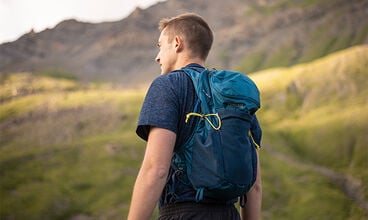
Hydration Packs
CamelBak packs are designed so you can easily adjust them to fit your own body type. Everyone has their own preferences, but here are some guidelines for figuring out where the pack should sit on your body: If your pack has a waist belt attached, try to set the shoulder straps so the waist belt lines up with the top of your hips. This will transfer some of the load from your hips to your waist, which means more stability and a better range of motion. If your pack has sternum straps, slide them up or down so the strap sits just above your abdomen. This will also help distribute weight more evenly across your body.
Don’t put your dirty pack in the washer, as doing so could potentially damage the straps or buckles. Instead, take your pack outside and rinse it off with a garden hose. If it’s extra super dirty, dunk your empty pack in a bucket or bathtub of soapy water, scrub it down, then rinse and hang it up to dry. CamelBak athlete Eric Porter explains it all in this video.
While personal preference is the biggest factor in what kind of pack works best for you, there are a few rules of thumb to follow.
- Waist Packs: Whether you want to call it a fanny pack, hip pack, or waist belt, these packs are perfect for a quick ride. They have space for water and just the essentials.
- Vests: Our Chase Bike Vest gives you more storage space than a waist pack, but still keeps your ride light. The vest design keeps your essentials (like fuel and phone) easily accessible and close to the body to prevent annoying bouncing. It’s minimal but offers space for a little extra cargo.
- Backpacks: Our bike packs offer anywhere from 1L to 17L of storage in addition to hydration. Depending on whether you’re bringing along just a light shed layer or food, layers, and gear, there’s a pack for you.
In this video, CamelBak athlete Eric Porter shares his top picks and the key attributes that make our bike packs perfect for any distance. His tips and tricks can be applied when thinking about hiking, running, and snow packs as well.
It can be intimidating to pack for a long day riding. For a safe and enjoyable day out on the trails, CamelBak athlete Eric Porter focuses on 4 key areas in addition to bringing plenty of water:
- Repair: Flat tires are among the most common issues, so you might need an inner tube and pump in addition to a tool kit.
- First aid: Make sure to bring the basics to stabilize common injuries so you can have a safe ride.
- Food: Keep up your energy with easy-to-access snacks.
- Weather prep: Make sure to bring gear you might need if the weather changes (jacket, rain gear, etc).
Sneak a peek at what Eric packs for big mountain biking adventures in the video below.
While many of our packs have weatherproofing features built in, in the event of heavy rain, you can instantly waterproof any pack with our Rain Cover pack accessory - it’s lightweight and super easy to use! In this video, CamelBak athlete Eric Porter shows you how to quickly attach the rain cover accessory to your pack so you can keep on riding.
Our Rain Covers are made specifically for different size packs:
- Rain Cover for S/M Hydration Packs - Fits packs between 1000 and 1500 cu in or 16L to 25L
- Rain Cover for M/L Hydration Packs - Fits packs between 1500 and 2300 cu in or 25L to 38L
Didn’t find what you’re looking for?
You can find additional product content and information at: